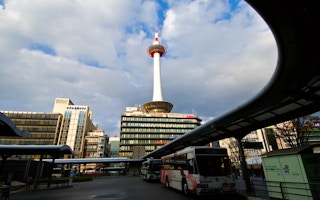Up to a third of the remaining global “carbon budget” that is not already locked in by existing operations could be determined by policies made at the urban level between now and 2020, according to a report from the C40 Cities Climate Leadership Group.
The carbon budget is a concept that refers to the total amount of emissions that human societies can put out but still keep the rise of global average temperatures within 2 degrees Celsius, the internationally agreed goal. The report refers to “locked in” carbon to discuss emissions already likely to take place, such as those over the lifetime of a power plant already in operation.
The pledges currently being put together by national governments constitute the core of international attempts to stay within this threshold of 2 degrees.
But the new findings, prepared in conjunction with the Stockholm Environment Institute, make a powerful case that local pledges toward climate-related goals will provide a meaningful contribution to stem a global need.
Negotiators are reaching crunch time this week in Bonn, Germany, as they try to iron out an agreement ahead of COP 21, the potentially historic conference on climate change set to start at the end of next month in Paris.
While reports are mixed about the progress being made behind closed doors at the headquarters of the United Nations Framework Convention on Climate Change, city leaders are plowing ahead armed with studies, like the new report, that support their claim that urban areas hold the key to reducing global emissions.
“This report shows how important urban policy decisions are to tackling climate change — and how mayors have great financial incentives to act,” said Michael R. Bloomberg, the UN secretary-general’s special envoy for cities and climate change. “Investing in modern and efficient infrastructure now, rather than continuing to expand traditional high-carbon infrastructure, will be four times less expensive over the long run.”
Bloomberg called the findings “the latest example of how fighting climate change is good for taxpayers.”
International diplomats are now wrangling over those remainder emissions beyond the “locked in” levels in an attempt to reach a global output of some 1,000 gigatons of carbon dioxide per year, a level that scientists say would be safe.
According to the new report, decisions made at the local level — for example, to improve the energy efficiency of buildings or to increase the use of low-carbon transport — could save up to 45 gigatons of CO2 by 2030. That’s equivalent to around eight times the current emissions put out by the United States.
Already, a host of local leaders from across the world have made such pledges through an initiative called the Compact of Mayors. In August, U. S. President Barack Obama called on all mayors to publicly commit to a climate action plan, and he set a goal of having at least 100 U. S. cities signing on to the compact by the end of November.
Others are even further along. Late last month, 10 global mayors, representing 58 million people and more than USD 3 trillion in gross domestic product, indicated that they had already met the reporting requirements to certify their climate action plans ahead of COP 21. On 4 December, city and regional officials from around the world will meet at Paris City Hall for a Climate Summit for Local Leaders.
While national governments continue to announce their emissions-reduction plans, known as Intended Nationally Determined Contributions, cities, regions, investors and companies have been tallying their own commitments through an online portal called the Non-State Actor Zone for Climate Action. As of 22 October, this UN-overseen database included more than 4,400 pledges.
Further, these 4,400 plans will take effect immediately after the conclusion of COP 21. The details being put forward by the national governments’ INDCs, on the other hand, will likely not be implemented until 2020.
Citiscope is a nonprofit news outlet that covers innovations in cities around the world. More at Citiscope.org.










